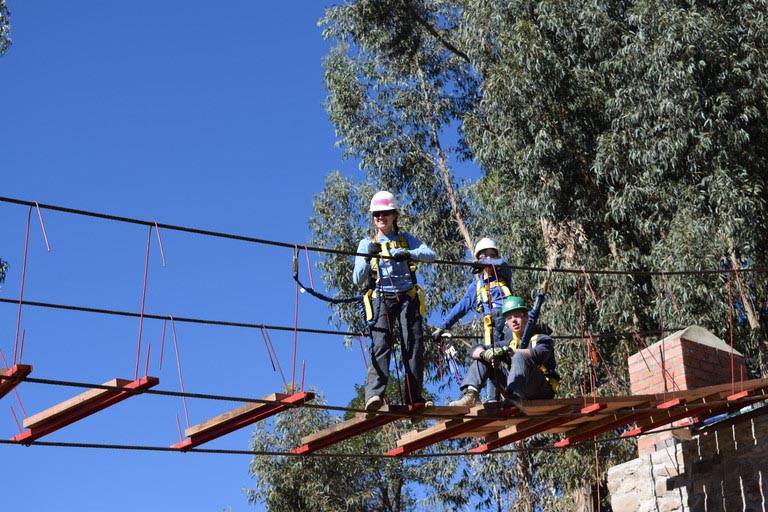
Penn State Engineers in Action participants take a break in their construction work in Bolivia for a group shot in summer 2019. IMAGE: ENGINEERS IN ACTION
Engineers in Action: Student group builds bridges for people in need
3/19/2020
By Mariah Chuprinski
UNIVERSITY PARK, Pa. — Years before they graduate or get their Professional Engineering license, students in Engineers in Action design and build bridges for people in need.
Each year since 2014, students involved with the Penn State College of Engineering’s chapter of Engineers in Action, formerly known as Bridges to Prosperity, have designed and planned the construction of a pedestrian footbridge to be installed in an isolated community in a developing country during the summer months.
This year, a team of three engineering students planned to travel to Lubanjiswano, Swaziland, to construct and install a suspended pedestrian footbridge over the course of seven weeks in May and June. In past years, the group has traveled to Bolivia, Rwanda and Panama.
Out of an abundance of caution during the ongoing coronavirus outbreak, Penn State canceled all University-affiliated student group travel through August 2020, putting the work of Engineers in Action temporarily on hold.
“We do everything from excavations to actual construction, including mixing and pouring concrete for the approach ramp, installing the handrail and crossway cables, setting the bridge’s sag and installing the bridge’s deck and fencing,” said Sofia McGoff, president of the chapter and third-year architectural engineering student planning to pursue the construction option.
The bridge is not merely installed for convenience. Its impact on the community is widespread, ensuring year-round access to essential resources such as education, health care and economic opportunities like employment and buying and trading goods at market.
Leading up to a trip, McGoff and her teammates communicate with a team of community members local to the bridge site, who work alongside Penn State students during construction. Student participants also work hard to learn the local culture that they will be immersed in leading up to the trip.
“We want to get the whole community involved, to make sure they feel that the bridge is theirs and they have ownership of it,” McGoff said. “When we leave, they need to know how to take care of and repair the bridge. Part of our mission is to make them feel they’re a vital part of our project and work alongside them.”
The group had been expecting about 70 Lubanjiswano community volunteers to assist students in the project this year.
Engineers in Action — a nonprofit organization that took ownership of the chapter in 2018 after Bridges to Prosperity changed the outreach focus of its mission — chooses the site for the group and does initial surveying and site work. The organization also provides engineers on record who check the students’ designs for safety and constructability.
“It’s a lengthy process to plan and construct the bridge,” said Sarah Halstead, second-year architectural engineering student. “We have to make all our reports and present to the national Engineers in Action organization members, who give us feedback and the notice to proceed. The process simulates the real world in that aspect — there’s so much oversight as we prepare to go in country.”
While developing plans, the group works closely with Penn State engineering alumni and former Bridges to Prosperity/Engineers in Action members, who are collectively known as the Bridge Corps.
Throughout the planning process, Bridge Corps members provide technical guidance and encouragement to students as they develop several technical reports for review by Engineers in Action, including the final report before traveling that deals with construction and safety planning. They also hold a construction seminar during the spring semester to teach members of the travel team critical construction skills to prepare for the bridge build.
Bridge Corps members also travel with the students to provide technical oversight during the construction process, which includes approving critical construction milestones, overseeing all safety protocols and helping students respond to challenges and make decisions.
“It's incredible that on these builds students have an opportunity to make a decision on an active construction project as if they had five or ten years’ experience in the construction industry,” said Steve Mezzacappa, 2017 architectural engineering alumnus, business development engineer with Turner Construction and Bridge Corps member for three years. “There is a large level of responsibility for students and my goal is to truly guide them in maximizing their growth, guiding them through the process of making well-informed engineered decisions within a parameter that upholds the integrity of the team and the project.”
The experience students gain in Engineers in Action reflects well to future employers, according to Halstead.
“Employers love the experience we acquire throughout the trip, including leadership opportunities, which are useful in the construction and engineering world,” Halstead said. “Last year, I got to travel to Bolivia with the group as a first-year student, a whole year before most engineering students get their first internship — giving me invaluable technical knowledge to start my second year.”
To get involved in the Penn State chapter of Engineers in Action, contact McGoff at sdm5582@psu.edu.
Engineers in Action fundraises throughout the year to pay for construction materials and other resources. To give to their campaign, mail checks made out to “Engineers in Action” to 123 Hammond Building, University Park, PA 16802.




